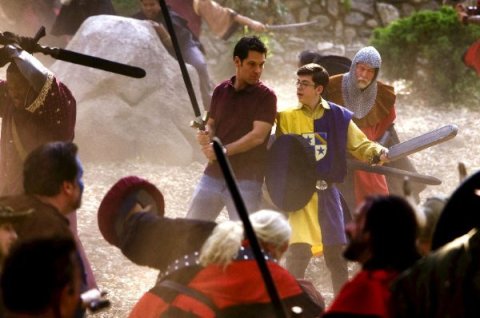The Next Big Thing Is More “Real” Than We Realize
Posted by Sasha Bailyn on Saturday, February 28th, 2015

The entertainment design industry loves to muse about the future. Typically, this means focusing on how technology will continue to enhance visitor experiences: we analyze trends with mobile devices and digital technology, preview the latest in interactivity and immersion, and keep tabs on futuristic gadgetry. But there’s one trend on the rise worth investigating, which in its purest form, does not require technology: Live Action Role Play (LARP).
LARP is “a type of interactive game in which live players assume roles and portray characters through physical action, often in costume and with props,” almost like classic childhood make-believe games (think cowboys and Indians). LARPing is often thought of as a nerdy pastime geared more towards fantasy lovers and social outcasts, as depicted in the comedy Role Models:

The classic image of LARP is people dressed in medieval garb, battling each other with foam swords. Other familiar variations include role-play shopping environments (such as the Renaissance Faire) and historical reenactments. But LARP has begun to take hold in other variations of mainstream entertainment, including interactive theatre, escape rooms, tech-based scavenger hunts, themed immersion camps, and even participatory cinema.
In all of these examples, we can see elements of LARP in the form of live, “active” adventures and role-play. But solving puzzles with friends or being pulled into a secret room by an actor is not quite the same as LARP. Pure LARPing is about having a sense of deep engagement and authentic participation in how the experience unfolds, which means that players can affect the course of events.
This unpredictability is both exciting and difficult to control, which is why true LARPs are nearly impossible to adapt to a large-scale setting. If you allow guests to become characters, you imbue them with the power to step “beyond the curtain” and enter the story. This means that participants have the potential to hijack or de-rail the production, threatening the integrity of the experience. There are ways of setting boundaries if participant groups are small, or made up of select, reverent members (like at the Harry Potter adult camp). But creating a LARP that is safe, affordable, and large enough for throughput at a leisure venue is quite challenging.
LARP seems like a perfect addition to a theme park or museum, given that it relies on thematic immersion (which can be adapted to any subject), gameplay, and social interaction. Its also has the potential to generate repeat visits because every experience is unique. But leisure venues must be able to predict and manage guests’ activity. Step One for integrating LARP seems to revolve around smart devices, point-collecting games, and scavenger hunts, which makes the experience quantifiable and easy to control. There’s nothing wrong with using technology to facilitate live action role-play, but so far, smart devices don’t seem to encourage the character adaptation and creative freedom that makes a true LARP.
Does LARP have a place in large-scale venues like a theme parks and museums? It’s hard to say at this point. But if live action role-play continues to be popular, the most compelling and lasting experiences will be those that rely on the “real” stuff: actors, environment, and most importantly, spontaneity and imagination.



 Sign Up For Our Newsletter
Sign Up For Our Newsletter 



